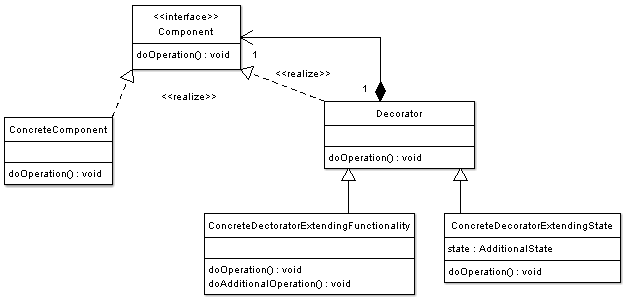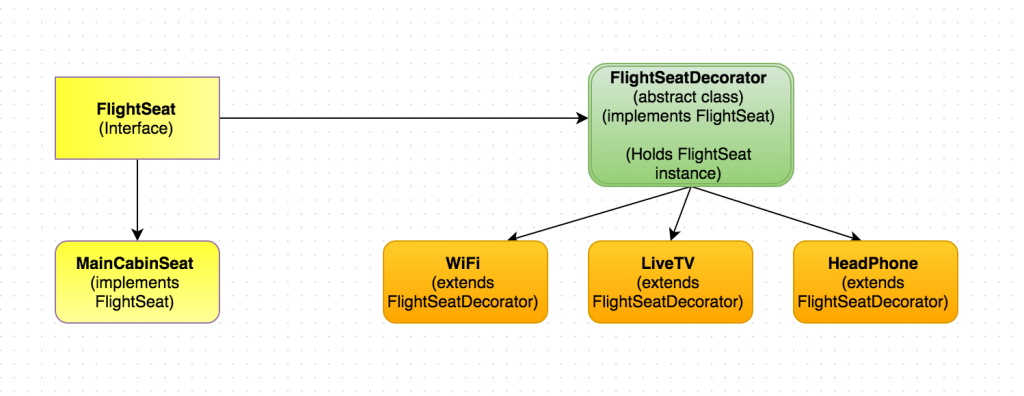Table Of Content

Now, assume one also desires the ability to add borders to windows. The ScrollingWindow subclass now poses a problem, because it has effectively created a new kind of window. If one wishes to add border support to many but not all windows, one must create subclasses WindowWithBorder and ScrollingWindowWithBorder, etc. This problem gets worse with every new feature or window subtype to be added. For the decorator solution, a new BorderedWindowDecorator is created. Any combination of ScrollingWindowDecorator or BorderedWindowDecorator can decorate existing windows.
Key Components of the Decorator Pattern
We want to implement a system where we can dynamically add these add-ons to a coffee order without modifying the coffee classes themselves. The Decorator Pattern (or an implementation of this design pattern in Python - as the above example) should not be confused with Python Decorators, a language feature of Python. “Wrapper” is the alternative nickname for the Decorator pattern that clearly expresses the main idea of the pattern.
Disadvantages of the Decorator Pattern in C++ Design Patterns
Also this pattern is really useful and commonly faced java interview question on design patterns. The Decorator Design Pattern promotes a flexible and maintainable way to enhance and extend the behavior of objects without the need to modify their core classes. It adheres to the Open-Closed Principle, which encourages software entities (classes, modules, etc.) to be open for extension but closed for modification. This pattern is beneficial when we need to add functionality to objects in a granular and reusable manner.
New Sewing Patterns
This pattern is useful when you need to add functionality to objects in a flexible and reusable way. Create a class named CarDecorator.cs, and copy and paste the following code. This will be an abstract class and implement the ICar interface, i.e., the ManufactureCar method.
When using the Decorator pattern, you often end up with a large number of small, specialized decorator classes. This can lead to a proliferation of classes in your codebase, which may increase maintenance overhead. The Decorator pattern promotes a clear and structured design, making it easier for developers to understand how different features and responsibilities are added to objects. The decorator pattern follows the open-closed principle, which states that classes should be open for extension but closed for modification.

The I/O Streams implementations of both Java and the .NET Framework incorporate the decorator pattern. The Decorator Design Pattern is a structural pattern that allows adding new functionality to an existing object without altering its original class. This pattern involves wrapping the original object in a decorator class, which has the same interface as the object it decorates. The decorator class then adds its behavior to the object during runtime, allowing for increased flexibility and modularity in programming.
80 Best Dining Room Ideas and Decorating Tips - Good Housekeeping
80 Best Dining Room Ideas and Decorating Tips.
Posted: Mon, 27 Nov 2023 08:00:00 GMT [source]
Applying decorators
However, the wrapping of a complex system provides a space that may be used to introduce new functionality based on the coordination of subcomponents in the system. For example, a facade pattern may unify many different languages dictionaries under one multi-language dictionary interface. The new interface may also provide new functions for translating words between languages. This is a hybrid pattern - the unified interface provides a space for augmentation. Think of decorators as not being limited to wrapping individual objects, but capable of wrapping clusters of objects in this hybrid approach as well.
We’re going to create a Shape interface and concrete classes implementing the Shape interface. We will then create an abstract decorator class ShapeDecorator implementing the Shape interface and having the Shape object as its instance variable. In the usual approach, you can create classes for each component to solve this problem. However, the problem is that the second class will have a complete duplicate of the first class and will only have an implementation of the “cancel” method. However, creating more than one class results in code duplication and disconnects each new variation of the component from its peers. This becomes even more complex if you have multiple login components, such as for desktop and mobile devices.
Structural Design Patterns
We already know the theoretical part of the decorator template from the first part of this article. In order to fix the material about the Decorator template, let’s look at a more approximate example. This example is not abstract and may occur to you while working on the project.
In the following, we’ll also provide a graphic and an example to explain how this works. Above problem can be solved easily by following class diagram. A similar class hierarchy can be build for client reports also.
Create concrete decorator class extending the ShapeDecorator class. At the top, you can see the ICar interface, which has the ManufactureCar method. The BMWCar concrete class implements this interface and provides the implementation for the ManufactureCar method. So, when we call the ManufactureCar method on the BMWCar object, it will return BMWCar without the Engine to the caller. Create a class file named DieselCarDecorator.cs and copy and paste the following code. This is a concrete class, and this class is inherited from the CarDecorator abstract class.

No comments:
Post a Comment